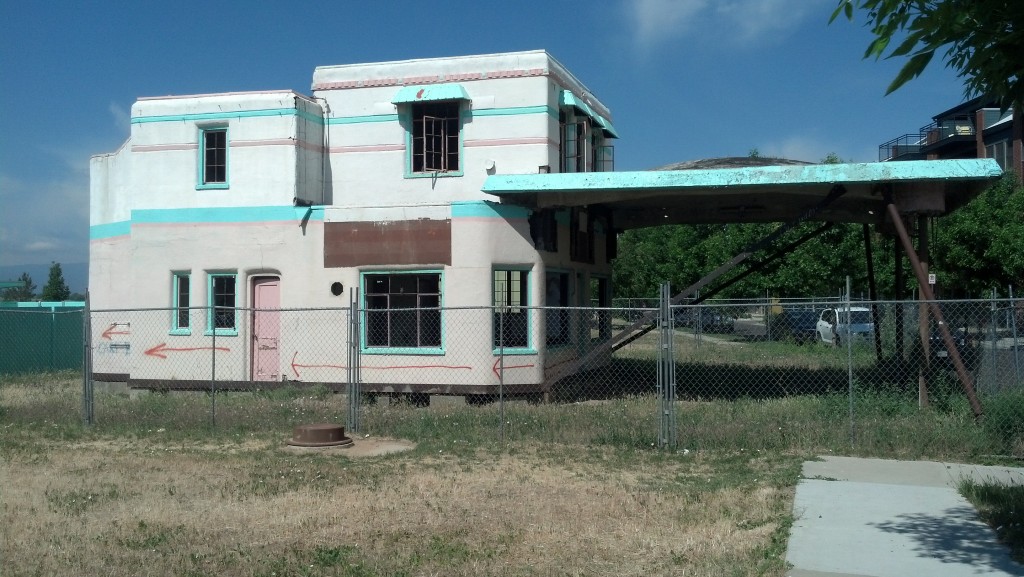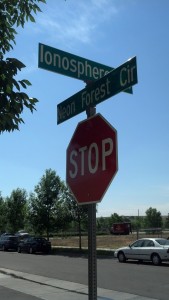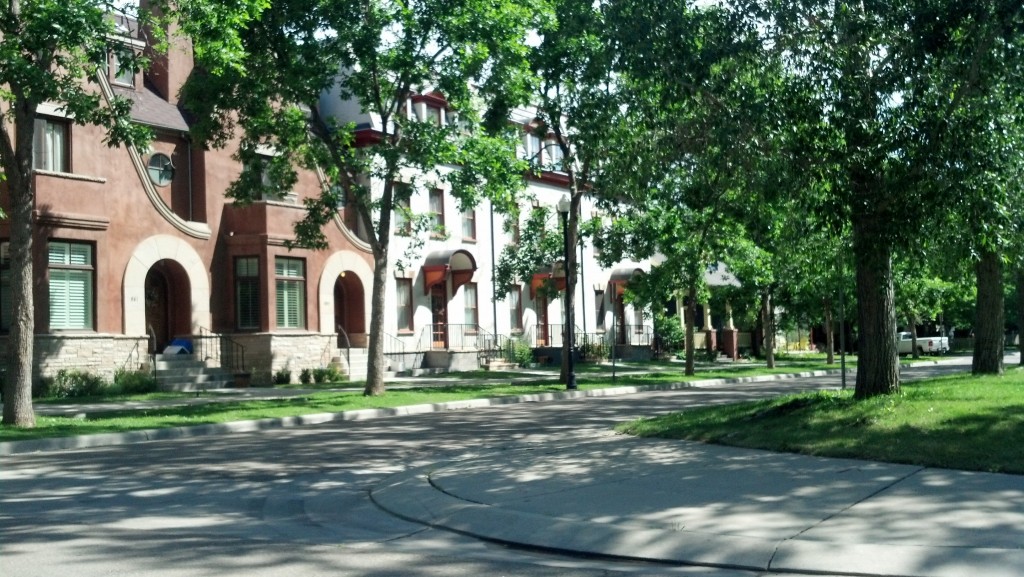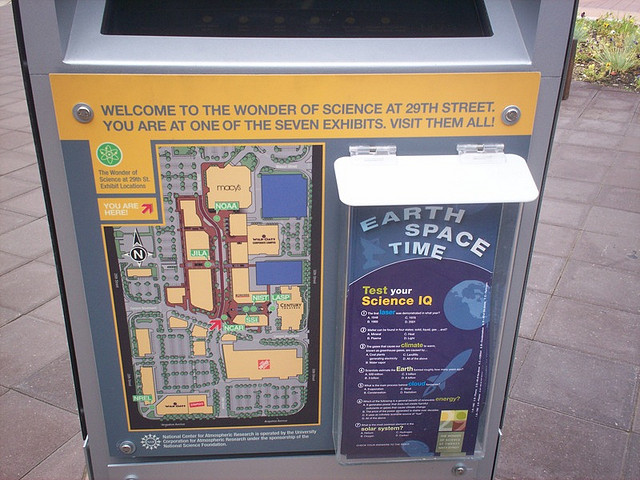
In “On the Road,” Jack Kerouac’s Sal Paradise slept on grass outside this gas station, which was moved into Prospect, a planned mixed-used community near Longmont, Colo.
(Photo by Michael E. Grass)
LONGMONT, Colo. — When Sal Paradise, the narrator and main character in Jack Kerouac‘s quasi-autobiographical novel On the Road, was on his way to Denver, he hitched a ride near Cheyenne, Wyo., from a guy from Connecticut driving cross-country in jalopy and painting along the way.
Taking the Denver-bound road closest to the mountains, Sal ended up here on the outskirts of Longmont for a short time.
Keroauc wrote in On the Road:
Under a tremendous old tree was a bed of green lawn-grass belonging to a gas station. I asked if the attendant if I could sleep there, and he said sure, so I stretched out a wool shirt, laid my face flat on it, with an elbow out, and one eye cocked at the snowy Rockies in the hot sun for a moment. I fell asleep for two delicious hours, the only discomfort being an occasional Colorado ant. And here I am in Colorado! I kept thinking gleefully. Damn damn damn! I’m making it!

To find the relocated Jack Keroac gas station, look for this intersection. (Photo by Michael E. Grass)
That On the Road gas station is still around according to Brian Butko’s Lincoln Highway Companion. It’s at the corner of Ionosphere Street and Neon Forest Circle at the edge of a mixed-used development near the junction of U.S. 287 and Pike Road.
It was moved here from its former location nearby at the intersection of U.S. 287 and Colorado State Highway 119. As I discovered, the Art Deco-inspired gas station sits vacant, is surrounded by a chain-link fence and does not yet sit on a permanent foundation.
Modern-day U.S. 287 is a six-lane divided highway that runs along Colorado’s Front Range and along the eastern flank of the gas station’s new home. According to the Lincoln Highway Association’s official map, the Lincoln Highway’s Colorado Loop through Denver follows today’s U.S. 287 or parallel roads nearby.
This is the way Kerouac (and Sal Paradise) would have used traveling between Cheyenne and Denver. This route passes through Fort Collins, Loveland, Longmont and Broomfield, but stays to the east of Boulder.
While there’s still some rich agricultural land and open space in this corridor, the greater expanse of Front Range suburbia encroaches along the route. During Kerouac’s time here, this area would have been considerably more rural.
Boulder County, through its comprehensive plan, concentrates growth in certain areas and limits it in others to preserve open spaces and agricultural land. This has helped keep the magnificent views of the Front Range relatively unblemished from taller buildings or other large structures that would the eat away at the great visual landscape.
The comprehensive plan has helped transform the city of Boulder into the great walkable and bikeable place it is. I love visiting Boulder as much as many residents enjoy living there. But there are critics, too, including property-rights activists, affordable-housing advocates and those who have pointed out that since surrounding communities weren’t subject to Boulder’s growth plan, the “5-10 mile ‘De-militarized’ zone wasn’t nearly wide enough.”
As a result, suburbia is just more spread out, though that may have been unavoidable considering growth along the Front Range the past few decades.
Post continues below …
The exurban development where the Kerouac gas station is now located, Prospect New Town, is a curious place. I wonder what would happen if Kerouac ended up waking up today somewhere in the vicinity of Neon Forest Circle. Would he expect to follow it and discover an actual neon forest? That would have been an awesome addition to On the Road, especially if Iggy Pop and his neon forest popped up in the process.
Prospect’s street names are certainly strange: Tempted Ways Drive, Tenacity Drive, Half Measures Drive, Confidence Drive and 100-Year Party Court stand out among the others which aren’t as interesting, like Allen Street.
Portions of Prospect New Town are quite architecturally diverse with mature trees and small lots, making this place feel more rooted than a typical new exurban subdivision. Some streets here might be mistaken for a dense older neighborhood in an established East Coast city.
That’s sort of the point however. Here is how Prospect New Town has described its planned approach, according to its website:
The New Urbanist planning movement proposes an antidote to conventional and sprawling suburban development, which is characterized by oversized front yards; wide, featureless streets; and inhospitable house fronts dominated by huge garage doors. Prospect, in common with other New Urbanist communities, instead features narrow tree-lined streets connecting homes to numerous parks and public amenities, shops and offices. Home types include detached houses, townhouses, courtyard houses, apartments, and live/work lofts. Mature trees have been planted along Prospect’s streets and in its parks to provide the shade and privacy typical of an established community.
While Prospect New Town is not Pleasantville, would Sal Paradise have felt comfortable in the shade and privacy typical in such an established community?
After his “refreshing sleep filled with cobwebby dreams of my past life in the East” at the gas station, Kerouac wrote that Sal had a “rich thick milkshake at the roadhouse to put some freeze in my hot, tormented stomach.”
Instead of the roadhouse, any modern-day Sal Paradise could simply visit Prospect’s town center on Tenacity Drive. There, anyone can go have the chicken piccata blue-plate special at the Two Dog Diner and then improve their personal wellness at the Solar Yoga studio next door.
***
As I was researching Kerouac’s Colorado travels during my stay in Boulder, I checked out the massive Twenty-Ninth Street shopping and entertainment complex a few times since it was located close to my hotel. Sure, Pearl Street is the historic commercial corridor that defines Boulder, but it’s Twenty-Ninth Street, its massive parking lots surrounded by clusters of strip malls and big-box retailers, that is Boulder’s modern commercial gravitational hub.
Twenty-Ninth Street is certainly better designed compared to most of suburbia I’ve experienced and is walkable, too — the automobile trumps the pedestrian experience in this complex — but at its heart, this place is suburbia, just repackaged along quasi streets boasting Nordstrom Rack, Macy’s, Apple Store, Lululemon, Smashburger, Mad Greens, covered walkways, solar panels, wind turbines and limited underground parking to limit customers’ exposure to the elements.
As many Americans are pivoting away from traditional indoor shopping malls — like the Richland Mall in Ohio, which I checked out earlier on my Lincoln Highway trip — they’re looking more to places like Twenty-Ninth Street. These are sometimes called “town center” developments. They’re also called “lifestyle centers,” which is a term that’s thoroughly amused me ever since I first heard developers use the phrase in the early 2000s.
And Twenty-Ninth Street is all about promoting a lifestyle conducive to spending money.
As I sat there in the sleek bright interior of Twenty-Ninth Street’s outpost of the Mod Market fast-casual chain, enjoying a Flatiron salad — a nod, perhaps, to Boulder’s famous Flatirons — I overheard a group of early-to-mid twentysomethings talking. They were roughly around the same age as Kerouac during his On the Road travels.
Boulder, home of the University of Colorado, has been a twentysomething’s paradise for years. But for all the great things about Boulder, it can be incredibly isolated, too.
“I’m restless,” one tall white guy with unkempt surfer-dude hair wearing a Rip Curl T-shirt said to his friends. “I need to get the f*** out of Boulder.”
His dark-haired female friend, who had a Tibetan prayer flag hanging off her backpack, asked: “Why don’t you move to Denver?”
“Denver? I can always just drive to Denver,” he said. “I was thinking someplace better.”
In this case, Colorado’s capital and largest city didn’t spark the same kind of wanderlust for this twentysomething dude as it did for Sal Paradise:
I pictured myself in a Denver bar that night, with all the gang, and in their eyes I would be strange and ragged and like the Prophet who has walked across the land to bring the dark Word, and the only Word I had was “Wow!”
The twentysomething dude at Twenty-Ninth Street listed a few desired potential locales, including — surprise! — Austin, Texas, Portland, Ore. and Seattle.
“But first I have to find a real job,” he said, looking already defeated.
The road is wide open, my friend.



Pingback: Make Way for the Wind Turbines | The Lincoln Highway Guide
Pingback: Unwelcome Signs in Wyoming | The Lincoln Highway Guide
Pingback: ‘This Is the Right Place’ for an ‘Obama Spy’ to Stop for Lunch | The Lincoln Highway Guide
Pingback: ‘This Is the Right Place’ for ‘One of Obama’s Spies’ to Stop for Lunch | The Lincoln Highway Guide
Pingback: Remember When Jack Kerouac Spent Time in Colorado?